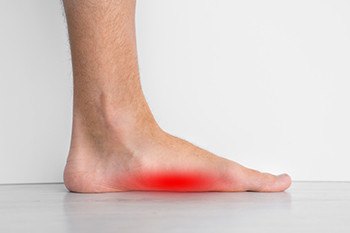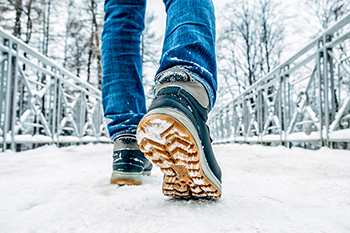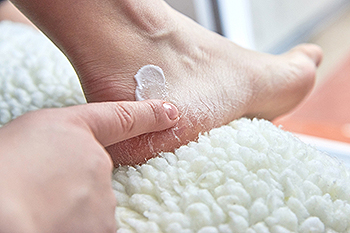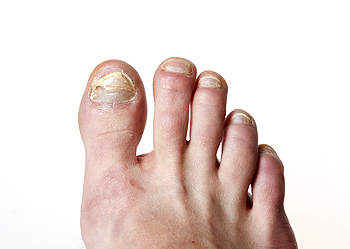Items filtered by date: January 2024
Types of Flat Feet

Flat feet, known as pes planus or fallen arches, entail the absence of a normal arch when standing, potentially causing discomfort during physical activities. This condition is common in infants, typically resolving as ligaments and tendons in the feet and legs tighten by ages 2 to 3. However, flat feet can persist into adulthood. Flat feet can result from injuries or illnesses, impacting walking, running, and prolonged standing. There are several types of flat feet, including flexible flat foot, tight Achilles tendon, and posterior tibial tendon dysfunction, each with its characteristics and potential causes. Risk factors for developing flat feet include genetics, physical activity levels, age, certain diseases like cerebral palsy and muscular dystrophy, obesity, hypertension, and diabetes. If you have flat feet and it is causing you discomfort, it is suggested that you schedule an appointment with a chiropodist for an evaluation and treatment options.
Flat feet are a common foot condition. If you are experiencing pain or discomfort due to flat feet, please consult with Chiropodist Stephanie Poupore from North Bay Foot & Ankle. Our clinician will assess your condition and provide you with quality foot and ankle treatment.
What Are Flat Feet?
Flat feet are feet that do not have a well-defined arch in the middle of the sole of the foot. Flat feet may be flexible or rigid. Flexible flat feet have an arch when there is no pressure put on the foot, such as when one is sitting, but the arch disappears upon standing. Rigid flat feet lack an arch regardless of whether one is standing or not.
Causes
Flat feet can be present from birth or acquired over time due to a weakening of the ligaments in the arch. Sometimes flat feet are caused by illnesses, injuries, or pregnancy.
Symptoms
Flat feet often cause no noticeable symptoms. However, some people may experience pain and discomfort due to their flat feet.
Symptoms associated with flat feet include:
Pain in the arch, heel, ankle, or along the outside of the foot
Overpronation of the foot
Shin splints
Aching or fatigue in the feet or legs
Pain in the knees, hips, or lower back
Treatment
In cases where flat feet cause symptoms, there are various treatments available. Wearing orthotic inserts in your shoes to provide more arch support, performing stretches, and taking medications may improve your symptoms. If you are overweight, losing weight can help relieve pressure on the feet. In severe cases, surgery may be considered.
If you have any questions, please feel free to contact our office located in . We offer the newest diagnostic and treatment technologies for all your foot care needs.
Choosing the Right Footwear for Winter Work

As winter unfolds its icy embrace, selecting the appropriate footwear becomes paramount for those engaged in outdoor work. Opt for sturdy, insulated boots that provide both protection and warmth against the season's harsh elements. Choose designs crafted from water-resistant materials to shield your feet from slush and snow, ensuring a dry and comfortable experience throughout the workday. Insulated linings, such as fleece or Thinsulate, add an extra layer of defense against the biting cold, maintaining optimal warmth even in freezing conditions. Look for slip-resistant soles to navigate icy surfaces safely, preventing slips and falls. Prioritize proper sizing to allow for circulation without compromising on insulation. It is beneficial to invest in high-quality winter boots tailored to the demands of your work environment. If you would like more information about foot protection during your winter workday, it is suggested that you visit a chiropodist who can provide you with the knowledge you are seeking.
If you stand all day, you may be at an increased risk of developing various foot conditions. If you are experiencing foot pain of any kind, please consult with Chiropodist Stephanie Poupore from North Bay Foot & Ankle. Our clinician will assess your condition and provide you with quality foot and ankle treatment.
What Foot Problems Are Caused by Standing?
Standing all day at work may increase your risk of developing foot or ankle problems.
Some common foot conditions that may arise from spending all day on your feet include:
Foot pain
Blisters
Corns and calluses
Arthritis
Flat feet
Bunions
Sprains
Athlete’s foot
Prevention
If you stand for prolonged periods of time for work, taking preventative measures to preserve the health of your feet is strongly recommended.
Measures you can implement to help prevent foot problems include:
Wearing shoes that are comfortable and fit well - these shoes should be made of breathable materials and provide you with arch support and cushioning. It is best to avoid shoes that have heels or narrow toe boxes.
Taking breaks to rest, walk, and stretch your feet throughout the day
Maintaining good foot hygiene - wash and dry your feet thoroughly every day
If you have any questions, please feel free to contact our office located in . We offer the newest diagnostic and treatment technologies for all your foot care needs.
Risk Factors for Individuals With Cracked Heels

With age, the development of calluses on the heels becomes a common occurrence. These patches of thick, dead skin, often a result of the pressure exerted while walking, can lead to a condition known as cracked heels. This ailment poses risks beyond discomfort, as painful cracked calluses not only hinder mobility but also create openings for bacteria, increasing the likelihood of infection. This is particularly concerning for individuals with diabetes or peripheral artery disease, PAD, where poor circulation in the legs and feet complicates the healing process. In cases where infection is suspected, it is indicated by pain, redness, pus, or swelling. Prompt attention is necessary, especially for those with diabetes or PAD. A chiropodist may examine the infected area to indicate what measures are required. Regular check-ups and diligent foot care are essential to prevent the recurrence of cracked heels. If you have developed this condition, it is suggested that you consult a chiropodist for treatment.
Cracked heels, also known as heel fissures, can cause pain and discomfort. If your cracked heels are bothering you, please consult with Chiropodist Stephanie Poupore from North Bay Foot & Ankle. Our clinician will assess your condition and provide you with quality foot and ankle treatment.
Dry, thickened skin around the rim of the heel is typically the first sign of cracked heels. While this condition is common and usually just a nuisance, some cases can be more severe. If left untreated and as more pressure is placed on the heel, the cracks become deeper and eventually walking and standing can be painful. These deep cracks or fissures can bleed and also become infected. Those with diabetes need to be especially careful as fissures could lead to diabetic foot ulcers.
Causes
Cracked heels can be the result of several different factors, including:
Dry skin
Taking long, hot showers or using harsh soaps
Standing for long periods of time
Walking barefoot
Walking in shoes with an open back, such as sandals or flip flops
Wearing shoes that do not fit properly
Living in a cold or dry climate
Certain skin conditions, such as eczema or psoriasis
Treatment
There are many at-home treatment remedies for cracked heels. Applying moisturizers to the heel can help hydrate the skin. Soaking your feet in warm water and exfoliating them with a loofah or pumice stone can help to buff away dead skin cells. If you are afflicted with cracked heels, it is recommended that you see a chiropodist for treatment.
Prevention
You can prevent cracked heels by:
Avoiding standing in one position for prolonged periods of time
Wearing well-fitted shoes with a closed back
Washing your feet with gentle soaps and lukewarm water
Moisturizing the feet daily
If you have any questions, please feel free to contact our office located in . We offer the newest diagnostic and treatment technologies for all your foot care needs.
Heel Pain in the Morning?
Slip and Fall Prevention in Winter Weather

Winter weather often leads to dangerous slips, trips, and falls, especially with icy surfaces. Taking simple steps can significantly reduce the risk of these accidents. Request a falls risk screening from your podiatrist as a starting point for discussion. Carry a small bag of lightweight kitty litter to help provide traction on slick surfaces. You can also prevent falls by installing a motion-sensor fall alarm system, higher toilet seats, multifocal glasses, grab bars, and more. When it comes to footwear, you can winterize your shoes, boots, and assistive devices. Attach spikeless ice and snowshoe gripper sole covers for added stability on slippery surfaces, available at sporting goods stores. Opt for winter shoes with rubber soles to maintain traction. These steps can help everyone stay safer during the winter months and reduce the risk of falls. If you have endured a fall due to inclement weather, it is suggested that you schedule an appointment with a chiropodist for an evaluation and treatment.
The winter months can bring about new or worsening foot and ankle problems. If you’re suffering from foot or ankle pain, please consult with Chiropodist Stephanie Poupore from North Bay Foot & Ankle. Our clinician can help you maintain the health of your lower limbs and your mobility.
Winter Foot Problems
Cracked heels - Dry, cracked skin on the heels of the feet that is associated with cold, dry weather
Athlete’s foot - A fungal infection on the skin of the feet
Blisters - Fluid-filled bubbles of skin that usually form in response to friction
Fractures - Broken bones in the feet or ankles
Metatarsalgia - General foot pain
Chilblains - Spasming of the small blood vessels in the toes in response to exposure to cold weather
Raynaud’s disease - Numbness, pain, and color changes in the toes due to cold weather
Prevention
Wear warm socks and shoes
Avoid prolonged exposure to the cold
Moisturize the heels regularly
Keep your feet clean and dry
Walk carefully in areas that may be icy
Wear non-slip shoes
If you have any questions, please feel free to contact our office located in . We offer the newest diagnostic and treatment technologies for all your foot care needs.
Managing Toenail Fungus

Toenail fungus, medically known as onychomycosis, is a common ailment that not only disfigures but can also lead to the destruction of the toenail. These microscopic fungi, akin to mold and mildew, thrive in the dark, moist, and stuffy environments inside shoes. As they grow, they feed on keratin, the protein responsible for the hard surface of toenails. Several factors increase the risk of developing toenail fungus. Included are wearing tight-fitting shoes, practicing poor foot hygiene, frequent use of toenail polish, and engaging in activities that expose you to communal environments, like showers or locker rooms. Additionally, chronic illnesses, such as diabetes, and circulatory problems that reduce blood flow to the toes can elevate the risk. Common symptoms include yellowing or browning of the toenail, thickening, foul-smelling debris accumulation, and even nail crumble or loss. The big toe and little toe are more prone to toenail fungus, possibly due to the constant friction from shoes. If you are concerned about toenail fungus, it is suggested that you schedule an appointment with a chiropodist.
Toenail fungus can be uncomfortable and unsightly. If you have diabetes or a compromised immune system, it may also be dangerous. To learn more about treatment options, please consult with Chiropodist Stephanie Poupore from North Bay Foot & Ankle. Our clinician will assess your condition and provide you with quality foot and ankle treatment.
What Does Toenail Fungus Look Like?
A fungal infection of the toenail may cause the affected nail to become thickened, brittle, crumbly, and yellowish or brown in color. Sometimes the toenail may separate from the nail bed, become deformed, emit a foul odor, or cause pain or discomfort.
What Causes Toenail Fungus?
Toenail fungus is caused by a fungus that infects the nail bed. The fungus lives and thrives in warm and moist environments and is also contagious. Athlete’s foot, which is a fungal infection of the skin, may spread to the nails and cause toenail fungus.
What Treatments Are Available?
Potential treatments for toenail fungus may include oral antifungal medications, topical antifungal medications, such as medicated nail polishes that are applied directly to the affected nail, and laser therapy. Sometimes, a combination of treatments is prescribed.
If you have any questions, please feel free to contact our office located in . We offer the newest diagnostic and treatment technologies for all your foot care needs.

